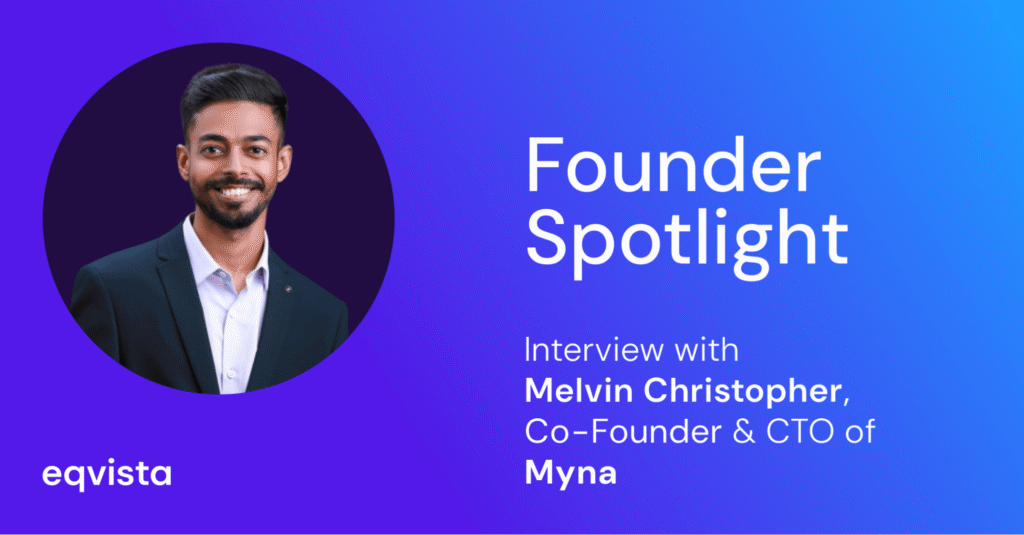Tech Meets Hospitality: How Myna AI Empowers Restaurants
In this edition of Founder Spotlight, we’re featuring Melvin Christopher, Co-Founder and CTO of Myna, Inc. Melvin is helping to shape the future of AI technology for the restaurant industry. In our interview, he discusses building scalable AI solutions, leading teams, and driving innovative ideas in digital marketing. His technical skills and entrepreneurial drive have enabled Myna, Inc. to stand out in automating customer acquisition and engagement for restaurants, utilizing generative AI and data analysis. Drawing from his own experience raising funds for Myna, Inc., Melvin explains how the company successfully secured $100,000 in its Angel Round, a meaningful milestone for the startup. Melvin’s innovative approach, as spotlighted in the Eqvista interview, combines operational excellence with strategic negotiation, empowering fellow founders to maximize their equity and drive long-term success.

Melvin, you’ve worked in diverse environments—from defense technology in Singapore to IT roles in U.S. academia and startups. How have these experiences influenced your leadership style at Myna?
You know, going from defense technology in Singapore to building AI for restaurants might seem like a huge jump, but it’s actually taught me something crucial – complex systems need simple interfaces. In defense, if your system isn’t dead simple under pressure, people die. In restaurants, if your app isn’t simple when the dinner rush hits, you lose customers. My time in academia showed me how to think systematically about problems, but startups taught me to ship fast and iterate. So at Myna, I lead with this philosophy, building sophisticated AI that feels like swiping on Tinder. We’re not here to impress other engineers, we’re here to help restaurant owners who are already juggling a million things.
You’ve led Myna from inception through rapid growth and a Techstars accelerator. What was the core problem you set out to solve in the restaurant industry, and how did your technical background shape that vision?
So Abishek and I actually started an SEO agency, and that’s when we had our ‘aha’ moment. We were doing all this manual analysis, checking reviews, optimizing local listings, creating content strategies, and I’m sitting there thinking ‘this is insane, we can automate 90% of this.’ This was when LLMs were just emerging, and I realized we could use AI to not just analyze but actually create solutions. We were spending hours on tasks that AI could do in seconds. That’s when we pivoted, why be another agency when we could build the AI that replaces agencies? The name Myna actually comes from these ancient messenger birds that kings used. We loved that metaphor, we’re the digital messengers helping restaurants spread their story to the world. Just like those birds carried important messages across kingdoms, we help small businesses get their message out across the digital landscape.
How did you approach investor outreach and what feedback did you receive regarding Myna’s AI-driven approach to restaurant marketing?
The investor conversations were fascinating. When we explained we came from running an agency and saw how broken the model was, they immediately got it. We weren’t just techies building in a vacuum, we’d felt the pain ourselves. The feedback that really shaped us was when one investor said ‘so you’re democratizing what big corps pay agencies $50K/month for?’ Exactly! We’re taking those enterprise-level insights and making them available to the local pizza shop for $300. The fact that we’d done this manually for clients gave us credibility, we knew exactly what worked.
How do you help restaurant owners measure the tangible impact of Myna’s AI-driven campaigns on their bottom line, and what challenges have you encountered in proving ROI to skeptical users?
Look, restaurant owners have been burned by tech promises before, so skepticism is totally valid. But here’s our advantage, we used to be the agency they’d hire! We know exactly what metrics matter because we used to report them manually. The biggest challenge? Getting owners to trust that AI can do what their expensive agency does. But once they see that first month where their Google ranking jumps or their review response rate hits 100%, they become believers. We literally show them the same reports agencies charge thousands for, but updated in real-time.
Myna’s platform helps restaurants to achieve 32–33% revenue growth, increase customer retention, and boost traffic. What features or strategies within Myna’s AI solution contributed most to these outcomes?
The magic comes from automating everything we used to do manually at our agency. Our AI receptionist? That replaced a $400/month answering service. But here’s the kicker, our Myna Score gamification. Restaurant owners are competitive! They love seeing their score beat competitors. It’s like we turned SEO rankings into a game. We learned from our agency days that clients never looked at boring reports, but they check game scores obsessively. The real innovation is packaging all these enterprise-level tools into something as simple as a dating app. Swipe right to post, swipe left to skip. No dashboards, no complexity.

As a hands-on CTO, how do you balance rapid prototyping and product stability, especially in a high-growth startup environment?
Having run an agency, I know what happens when tech fails – clients scream. So we have what I call ‘mission-critical’ and ‘experimental’ features. The AI receptionist, review responses, those are mission-critical. They work 99.9% of the time because restaurants depend on them. For new features, we move fast. We’ll test a new AI strategy with 10 restaurants, see what happens, and iterate. Our architecture assumes Murphy’s Law is always in effect. Plus, starting as an agency gave us a huge advantage. We already knew what features to prioritize. We didn’t waste time building things restaurants don’t actually use.
Congratulations for $100,000 funding in Angel Round. What were the key metrics or milestones that helped you secure this latest round of funding?
The angel round came together because we had a unique story. We weren’t just engineers with an idea, we’d run an agency, felt the pain, and built the solution. When we showed investors that we were essentially replacing $3K/month agency services with $300 AI, the unit economics spoke for themselves. Our beta tester engagement was insane, restaurants checking the app multiple times daily. But the real proof was showing how we automated our own agency’s work. We literally demonstrated: ‘This task took us 3 hours manually, Myna does it in 30 seconds.’ Hard to argue with that efficiency gain.
What lessons did you learn from this funding process that you would share with other founders seeking early-stage capital in the AI for restaurants sector?
When we led with ‘we ran an agency and realized it’s broken,’ investors immediately understood the problem. It’s different from ‘we think restaurants need help’ – we KNEW they needed help because they were paying us! Document everything from your previous business that supports your pivot. We showed our old agency invoices, time logs, client results, all proof that the market exists and pays premium prices for these services. Also, highlight your unfair advantages. Ours was knowing exactly what restaurants need because we’d served dozens of them. That insider knowledge is gold to investors.
Looking ahead, how do you see AI transforming customer engagement in the restaurant sector over the next five years?
Five years from now? Every restaurant will have an AI chief marketing officer. Not just responding to reviews, predicting customer trends, optimizing pricing, personalizing every touchpoint. The local Thai place will have the same customer intelligence as McDonald’s. What excites me most is democratization. When we ran our agency, only big restaurants could afford us. Now, AI gives everyone access to enterprise-level strategies. The playing field isn’t just leveling – it’s being completely reimagined.
But here’s the thing, AI won’t replace the human touch in hospitality. It’ll handle the digital grunt work so owners can focus on what matters: creating amazing experiences. We’re not replacing restaurants, we’re amplifying them.
Any advice for aspiring technical founders building in traditional industries?
First, solve your own problem. We built Myna because we were drowning in manual SEO work. When you’ve felt the pain personally, you build better solutions. Don’t guess what users need, know it. Second, use familiar interfaces. We made Myna feel like Tinder because everyone knows how to swipe. Your revolutionary backend doesn’t need a revolutionary frontend. Restaurant owners don’t want to learn new things at 8pm on a Friday. Third, find a co-founder you trust completely. Abishek and I have been friends for 20+ years – I was his best man! That deep trust is crucial when things get tough. And they will get tough.
